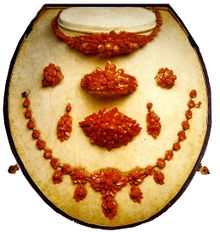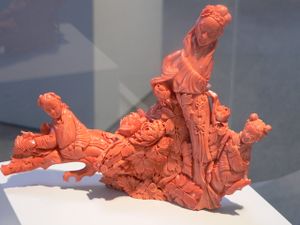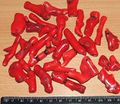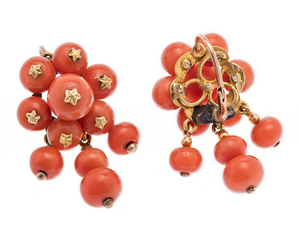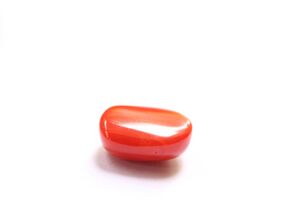مرجان (حجر كريم)
| المرجان Precious coral | |
|---|---|
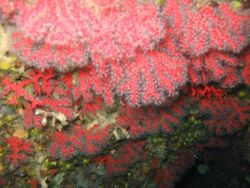
| |
| Corallium rubrum (Amphitrite's underwater cave - Alghero, ساردينيا) | |
| التصنيف العلمي | |
| مملكة: | |
| Phylum: | |
| Class: | |
| Subclass: | |
| Order: | |
| Family: | |
| Genus: | Corallium
|
| أنواع | |
|
حوالي 25 نوع،انظر النص. | |
المرجان أو المرجان الأحمر Precious coral، هو أحد أشهر الأحجار الكريمة بالرغم من أنه لا يعد من المواد المعدنية، بل يعتبر من المواد الحيوانية (العضوية). والمرجان هو أحد المواد العضوية الأكثر قدماً في الاستعمال في صناعة الحلي، حيث ظل المرجان عشرين قرناً يصنف مع الأحجار الكريمة الثمينة، ولكنه فقد بعض شعبيته لمدة معينة، ثم بدأ يستعيد مكانته وشعبيته في السنوات الأخيرة. والمرجان يتركب من مادة كربونات الكالسيوم. والمادة المرجانية الحمراء هي الهيكل الصلب لمستعمرة المرجان، وهي التي تعطينا شكلها المألوف، وتتركب هذه المادة من شويكات دقيقة حمراء اللون يفرزها حيوان المرجان، وبعد إفرازه هذه الشويكات تتماسك مع بعضها البعض، وتخرج هذه الأفراد التي تستخدم كل منها في صناعة الحلي.
وقد عرَّفه العالم العربي الجواهري (التيفاشي) بقوله: "والمرجان متوسط بين عالمي النبات والجماد، وذلك أنه يشبه الجماد بتحجره، ويشبه النبات بكونه أشجار نابتة في عقر البحر ذوات عروق وأغصان خضر متشعبة قائمة". .[1]
. . . . . . . . . . . . . . . . . . . . . . . . . . . . . . . . . . . . . . . . . . . . . . . . . . . . . . . . . . . . . . . . . . . . . . . . . . . . . . . . . . . . . . . . . . . . . . . . . . . . . . . . . . . . . . . . . . . . . . . . . . . . . . . . . . . . . . . . . . . . . . . . . . . . . . . . . . . . . . . . . . . . . . . .
الموئل
التشريح
تترواح الألوان الرئيسية للمرجان بين اللون الأبيض إلى اللون الوردي والأحمر الداكن، ومن الألوان الشائعة والتي تلقى إقبالاً عليها اللون الوردي والأحمر القاني، كما يوجد المرجان باللون الأسود، وهو عبارة عن مادة عضوية لونها غامق تتواجد في مياه المحيط الهادئ. أندر أنواعه هو المرجان الدموي.
الأنواع
الأنواع المعروفة من جنس المرجان:[2]
المرجان كحجر كريم
The hard skeleton of red coral branches is naturally matte, but can be polished to a glassy shine.[3] It exhibits a range of warm reddish pink colors from pale pink to deep red; the word coral is also used to name such colors. Owing to its intense and permanent coloration and glossiness, precious coral skeletons have been harvested since antiquity for decorative use. Coral jewellery has been found in ancient Egyptian and prehistoric European burials,[4] and continues to be made to the present day. It was especially popular during the Victorian age.[5]
Precious coral has hardness 3.5 on the Mohs scale.[6] Due to its softness and opacity, coral is usually cut en cabochon, or used to make beads.[7]
مصائد المرجان
تنتشر أهم المصائد العالمية التي يستخرج منها المرجان عن بعض شواطئ البحر المتوسط، حيث المورد التقليدي للمرجان، فبالقرب من شواطئ هذ البحر وحول الجزر الموجودة فيه تنتشر مستعمرات المرجان بدرجة كبيرة، وهي تعيش على أعماق متباينة، فيوجد البعض منها في المياه الضحلة التي لا يزيد عمقها عن 50 قدماً بينما يوجد البعض الآخر على أعماق تصل إلى ما يزيد عن 1000 قدم[8]. وتنشر مصائد المرجان الأحمر على شواطئ تونس والجزائر والمغرب ، كما يوجد البعض منها على الساحل الجنوبي لفرنسا وحول جزر البحر الأبيض المتوسط، مثل جزر سردينيا وقورسيقا وصقلية. بينما يكثر المرجان الأحمر في قارة آسيا حول جزر ريوكان (Ryukuan) في جنوب اليابان. ويتم استخراج المرجان في المنطقة الواقعة بين أوكيماوا ومياكو (Miyako and Okimawa) باليابان من أعماق تتراوح ما بين 1000 إلى 1300 قدم. كما يوجد بكثرة في أمريكا حيث اكتشف فيها نوع من المرجان بلون بنفسجي في جنوب كاليفورنيا. أمل المرجان الأسود الذي ينمو بنجاح كبير حول الأرخبيل الماليزي (Archipelago Malaysian) وشواطئ الجزء الشمالي من أستراليا وفي البحر الأحمر كما تتواجد في اليابان و تايوان.[3] ويستخرج المرجان بدرجة محدود من مياه المحيط الأطلنطي بالقرب من الشطائ الشمالي الغربي لأفريقيا. وما أن أدكت البلاد الأوروبية الواقعة على شاطئ البحر المتوسط أهمية المصائد الموجودة بالقرب من شمال أفريقيا حتى ظهرت بينها منافسة شديدة لاحتكار هذه المصائد والسيطرة عليها.
العناية بالمرجان
يتطلب المرجان عناية خاصة، وذلك لأنه من الأحجار اللينة، لذا يجب ممارسة بعض الاحتياط عن لبسه، كما يوصي بحفظه في مكان منفصل أو في قماش خاص بالأحجار الكريمة يضع في صندوق خاص بع بعيداً عن الأحجار الكريمة الأكثر صلابة.[3] أما الأحماض فيجب الابتعاد عنها، وعدم تعريض المرجان لهذه الأحماض لأنها تتلفه مهما كانت مخففة، حيث تتفاعل بسهولة مع كربونات الكالسيوم المكونة لها، لذا يجب ألا تتعرض لمثل هذه المواد أيضاً (الخل أو عصير الليمون أو الصابون وحتى عرق بعض الأجسام). ولقد أشار إلى هذه الحقيقة العالم العربي الجواهري التيفاشي في كتابه القيم "أزهار الأفكار في جواهر الأحجار" بقوله:
| "إذا ألقي في خال لان وأبيض". كما ذكر (التيفاشي) أيضاً طريقة لعلاج هذه العيوب بقوله: "وأنه إذا ألقي في الدهن أظهر حمرته وأشرق وحسن لونه وفعل في ضد فعل الخل." | ||
وأما من الناحية العلمية فيوضع المرجان الذي بهت لونه في حامض بيروكسيد الهيدروجين حتى يستعيد لونه. وتبلغ صلابته على مقياس موس للصلابة 3.5[6].
تاريخ تجارة المرجان
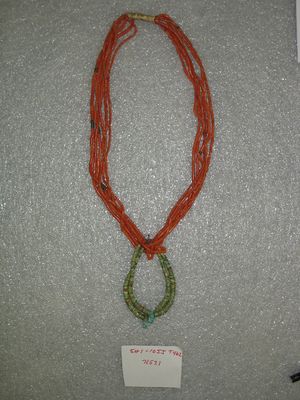
At the beginning of the 1st millennium, there was significant trade in coral between the Mediterranean and India, where it was highly prized as a substance believed to be endowed with mysterious sacred properties. Pliny the Elder remarks that, before the great demand from India, the Gauls used it for the ornamentation of their weapons and helmets; but by this period, so great was the Eastern demand, that it was very rarely seen even in the regions which produced it. Among the Romans, branches of coral were hung around children's necks to preserve them from danger from the outside, and the substance had many medicinal virtues attributed to it. The belief in coral's potency as a charm continued throughout the Middle Ages and early in 20th century Italy it was worn as a protection from the evil eye, and by women as a cure for infertility.
From the Middle Ages onward, the securing of the right to the coral fisheries off the African coasts was the object of considerable rivalry among the Mediterranean communities of Europe.
The story of the Torre del Greco is so interwoven with that of the coral so as to constitute an inseparable pair, and is documented as early as the fifteenth century. In 1790 the Royal Society of Coral was established in the town of Torre del Greco, with the idea of working and selling coral fish. This shows that the coral fishing flourished for many years in the city.[بحاجة لمصدر]
It was also enacted December 22, 1789, by Ferdinand IV of Bourbon Code coral (prepared by the Neapolitan jurist Michael Florio), with the intent to regulate the coral fishing in those years starring, in addition to the sailors Torre del Greco, the locals and those in Trapani This regulation did not have the expected success. From 1805, when he founded the first factory for the manufacturing of coral in Torre del Greco (by Paul Bartholomew Martin, but with French Genoese origin), the golden age for the manufacturing of coral in the city situated on the slopes of the Vesuvius started, because working together with the coral fishing was increasingly under the control of Torre del Greco fishermen. Since 1875, the Torre del Greco began working with the Sciacca coral and a school for the manufacturing of coral was built in 1878 in the city (which closed in 1885 to reopen in 1887), with which in 1933 established a museum of the coral. Then came the time of processing of Japanese coral found in the markets of Chennai and Kolkata.[بحاجة لمصدر]
Other story instead a short period the Tunisian fisheries were secured by Charles V for Spain; but the monopoly soon fell into the hands of the French, who held the right until the Revolutionary government in 1793 threw the trade open. For a short period (about 1806) the British government controlled the fisheries, but this later returned to the hands of the French authorities. Before the French Revolution much of the coral trade was centred in Marseille, but then largely moved to Italy, where the procuring of the raw material and the working of it was centring in Naples, Rome and Genoa.[9]
. . . . . . . . . . . . . . . . . . . . . . . . . . . . . . . . . . . . . . . . . . . . . . . . . . . . . . . . . . . . . . . . . . . . . . . . . . . . . . . . . . . . . . . . . . . . . . . . . . . . . . . . . . . . . . . . . . . . . . . . . . . . . . . . . . . . . . . . . . . . . . . . . . . . . . . . . . . . . . . . . . . . . . . .
في الثقافة
The origin of coral is explained in Greek mythology by the story of Perseus. Having petrified Cetus, the sea monster threatening Andromeda, Perseus placed Medusa's head on the riverbank while he washed his hands. When he recovered her head, he saw that her blood had turned the seaweed (in some variants the reeds) into red coral. Thus, the Greek word for coral is 'Gorgeia', as Medusa was one of the three Gorgons.[10]
Poseidon resided in a palace made of coral and gems, and Hephaestus first crafted his work from coral.
The Romans believed coral could protect children from harm, as well as cure wounds made by snakes and scorpions and diagnose diseases by changing colour.
- In Hindu astrology red coral is associated with the planet Mars or Graha-Mangala and used for pleasing Mars. It should be worn on the ring finger.
- A branch of red coral figures prominently in the civic coat of arms of the town of Alghero, Italy.
- In Islam coral is mentioned as one of the gems in paradise.
- Amongst the Yoruba and Bini peoples of West Africa, red precious coral jewellery (necklaces, wristlets and anklets most especially) are signifiers of high social rank, and are worn as a result by titled kings and chieftains.
- In traditional Dutch culture, notably in fishing communities, red coral necklaces were worn by the female population as an indispensable part of the traditional costumes.[11]
الحفاظ
Intensive fishing, particularly in shallow waters, has damaged this species along the Mediterranean coastline, where colonies at depths of less than 50 metres are much diminished. Fishing and now climate change threaten their persistence. The three oldest Mediterranean marine protected areas—Banyuls, Carry-le-Rouet and Scandola, off the island of Corsica—all host substantial populations of C. rubrum. Since protection was established, colonies have grown in size and number at shallow and deeper depths.[12][13]
انظر أيضاً
المصادر
- ^
 "Coral". Encyclopædia Britannica (11th ed.). 1911.
"Coral". Encyclopædia Britannica (11th ed.). 1911.
- ^ "WoRMS - World Register of Marine Species - Corallium Cuvier, 1798". Marinespecies.org. 2004-12-21. Retrieved 2013-10-09.
- ^ أ ب ت
"Gemstones: Coral". Archived from the original on 2007-02-09. Retrieved 2007-02-15. خطأ استشهاد: وسم
<ref>غير صالح؛ الاسم "gemstone.org" معرف أكثر من مرة بمحتويات مختلفة. - ^ خطأ استشهاد: وسم
<ref>غير صحيح؛ لا نص تم توفيره للمراجع المسماةMarenostrum - ^ Anderson, Katharine (2008). "Coral Jewellery". Victorian Review. 34 (1): 47–52. doi:10.1353/vcr.2008.0008. JSTOR 41220397. S2CID 201782824.
- ^ أ ب "Jewelry Central". Retrieved 2007-02-15. خطأ استشهاد: وسم
<ref>غير صالح؛ الاسم "JewelryCentral" معرف أكثر من مرة بمحتويات مختلفة. - ^ Balzan, Francesca; Deidun, Alan (2010). "Notes for a history of coral fishing and coral artefacts in Malta - The Significance of Coral: Apotropaic, Medical, Symbolic, Precious". In Joseph F. Grima (ed.). 60th anniversary of the Malta Historical Society: a commemoration. Zabbar: Veritas Press. pp. 435–454. ISBN 978-99932-0-942-3. OCLC 779340904. Archived from the original on 25 March 2019.
- ^ "Corallium species". ARKive. Archived from the original on 2007-06-20. Retrieved 2007-02-15.
- ^
 Chisholm, Hugh, ed. (1911). . دائرة المعارف البريطانية. Vol. 7 (eleventh ed.). Cambridge University Press. p. 131.
Chisholm, Hugh, ed. (1911). . دائرة المعارف البريطانية. Vol. 7 (eleventh ed.). Cambridge University Press. p. 131. {{cite encyclopedia}}: Cite has empty unknown parameter:|coauthors=(help) - ^ "Ovid's Metamorphoses". Metamorphoses. Retrieved 2014-11-06.
- ^ "Traditional dutch red coral necklace". Retrieved 2022-08-24.
- ^ "Marine protected areas conserve Mediterranean red coral". Sciencedaily.com. 2010-05-11. Retrieved 2013-10-09.
- ^ Linares, C.; Bianchimani, O.; Torrents, O.; Marschal, C.; Drap, P.; Garrabou, J. (2010). "Marine Protected Areas and the conservation of long-lived marine invertebrates: The Mediterranean red coral". Marine Ecology Progress Series. 402: 69. Bibcode:2010MEPS..402...69L. doi:10.3354/meps08436. hdl:10261/79508.
وصلات خارجية
- قالب:ARKive
- International Colored Gemstone Association Extensive info on gemstone coral and jewelry photos (Accessed 2 February 2007)
- American Gem Trade Association Information on coral as a gemstone (Accessed 2 February 2007)
- Information on black coral jewelry care and characteristics
- Organic Gems: Red Coral Jewelry Photos of raw coral material and coral jewelry (Accessed 2 February 2007)
- Mediterranean red coral: research team International Research Team on Mediterranean red coral (Accessed 15 March 2007)
- The state of red coral (Corallium rubrum) populations in the N.W. Sardinian fishing grounds(Accessed 16 September 2010)
- FAO

